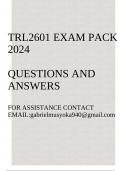Exam (elaborations)
TRL2601 Exam pack 2024(Transport Management I)
- Course
- Transport Management I
- Institution
- University Of South Africa
TRL2601 Exam pack 2024(Transport Management I) With accurate answers and assurance that they are in the exam
[Show more]



